北の生活文化(Traditional festivals in coastal areas )
| Festivities carried out in Hokkaido include religious festivals to express a connection to gods and deities. These festivities were brought by immigrants from their original village. Other forms of festivities have a distinct local identity and have spontaneously emerged from rural villages in the hope of fostering and increasing social solidarity in the community. |
| Traditional festivals in coastal areas |
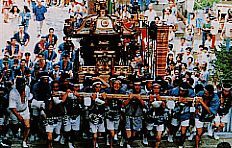 |
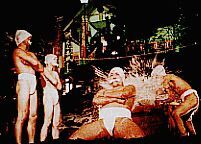 |
| 109. Hakodate Hachiman Shrine Festival in Hakodate |
110. Ritual of Midwinter Ablution at Samegawa Shrine
in Kikonai |
Many festivities with a long history and strong connections with the fishing industry have emerged in coastal areas. Among these are the large-scale, magnificent festivals of the Shinto shrines, known as the "Hakodate Hachimangu Reisai" and the "Ubagami Daijingu Reisai" in Esashi both of which are reminiscent of the prosperity once brought about by herring fishing. "Hakodate Hachimangu Reisai" which was already held in 1780 is carried out for three days from the 14th till the 16th of August and is highlighted by the passage of portable shrines (mikoshi) on its second day. In this Shinto ritual, three portable shrines including the most sacred shrine, one devoted to swordsmanship and one connected with kindergartens are swiftly carried up the 134 stone steps. The "Ubagami Daijingu Reisai" features a parade of 13 festival floats including one named "Jingu Yama" which was made around 1750s. These floats proceed through the town until late in the night from August 9 to 11. The musical accompanists who play bamboo flutes and drums are aboard the floats playing tunes that are believed to be variations on some played at Kyoto's "Gion Matsuri" Festival. The splendor displayed in this festival is enchanting for many people.
The most notable among the ceremonies connected with promoting a good harvest is the Shinto ritual known as "The Midwinter Ablutions of Samegawa Shrine" held from January 13 to 15. Its origin is found in the anecdote which relates the story of a priest who conducted midwinter ablutions on January 17 following a divine revelation he had received in a dream. This event occurred around the year 1831 and resulted in a good agricultural harvest and fishing catch. Four young men have taken part in this ceremony in the cold winter sea ever since that time. |
| Traditional festivals in inland areas |
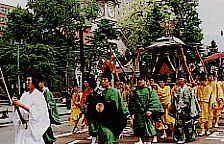 |
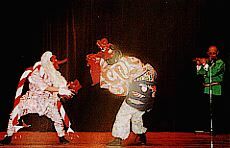 |
| 111. Festival of Hokkaido Shrine in Sapporo |
112. Shishimai at Moseushi Shrine in Moseushi |
The Hokkaido Shrine, formally the Sapporo Shrine, was founded in 1869 and consecrated under an imperial edict to three deities specifically connected with sucessful development. Forty-three other shrines were built subsequently which were sacred to these three deities. The foundation of these shrines to worship three deities for development reflects the intent of the settlers' leaders and the farm managers to promote cohesiveness and foster a positive attitude toward development and settlement in Hokkaido among immigrants with different origins and backgrounds.
The Hokkaido Shrine Festival of June 14 to 16 was officially established by the Hokkaido Development Commission beginning in 1873. This event has been called Sapporo Matsuri (Sapporo Festival) and cherished by local people since that time. Four portable shrines (mikoshi) with seven floats made around the 1910s are accompanied by cheerful music for the festival and by a parade of 1,425 people.
Among the shrines consecrated to the three deities, built since 1877, is the Moseushi Shrine whose festival takes place on September 14 and 15. In the festival, the shrine which was consecrated to the god that presides over the region of the settlers from Shikoku serves as the sacred area for the temporary enshrinement of the mikoshi during the procession. The Shishimai or Lion dance which was brought by the immigrants from Toyama prefecture is held along with the practice of ceremonial ablutions. Thus, the festivities of Hokkaido have developed often through the process of fusion of various forms of culture brought by the immigrants. |
| Shinto music and dance (Kagura) |
 |
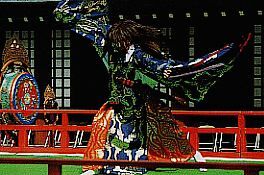 |
113. A piece from Matsumae Kagura for peace
and good harvest |
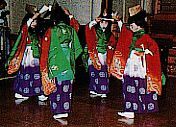 |
114. A piece from Daidai Kagura for increasing
prosperity |
115. A piece from Sanjo Kagura exorcising evil spirits |
Popular performing arts have emerged spontaneously from people's belief in deities. Based upon the styles of performing arts such as the lion dance that the settlers had brought from their original villages, drum performances and other forms of art were subsequently added in the process of developing the local identity of the villages.
The kagura style of dance and music is performed in the course of worshiping Shinto gods and this type of performance is best represented by the Matsumae kagura. It is believe to have been performed first in 1674 at Matsumae castle, formerly Fukuyama, being officially appointed to Lord Norihiro, the 6th head of the Matsumae clan. Kagura of this style is performed mainly at shrines in the south of Hokkaido. The fact that the Matsumae Kagura is traditionally performed and transmitted by the Shinto priests alone has contributed to the refinement of its artistry. Among the kagura dances performed by ordinary people is the Sanjo Kagura which is a variation of the kagura from Hachimangu Shrine in Sanjo city in Niigata prefecture. Also known as Dai Dai kagura, this particular style of performance was adopted by the Hokkaido Shrine, the Sumiyoshi Shrine in Otaru, the Muroran Hachiman Shrine, the Nopporo Shrine and the Takikawa Shrine among others, though kagura is no longer performed at the Takikawa Shrine. Kagura of this sort was developed after the settlers who came from the Sanjo area invited performers of ancient court music from their town of origin to dedicate their performance to the shrine. The Dai Dai kagura is performed by ordinary people of the community unlike the Matsumae Kagura which is performed by priests. |

